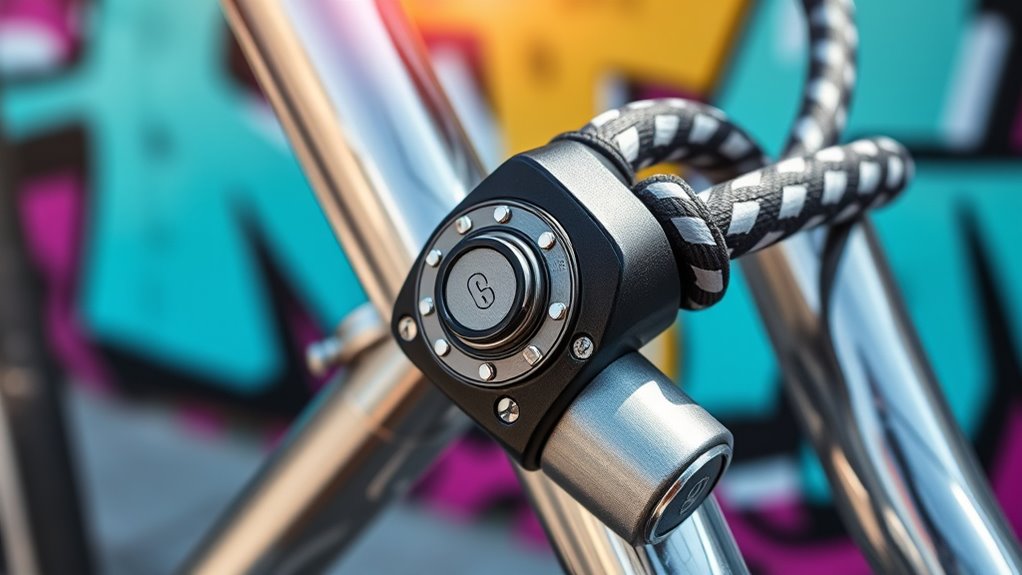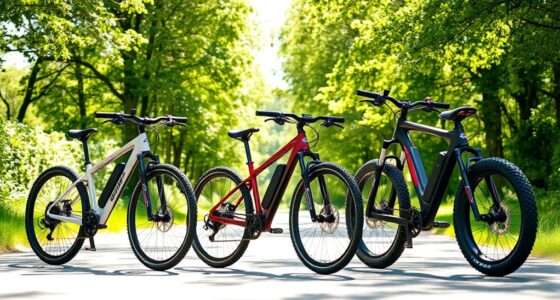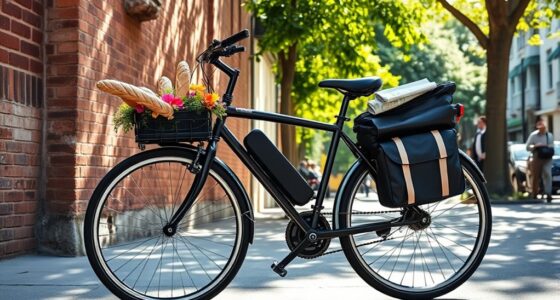To prevent bike theft, choose a high-security lock made of hardened steel with a hardened shackle or shrouded design. Use a lock that resists cutting, sawing, and picking, and position it properly—locking your frame and at least one wheel to a sturdy, immovable object in well-lit, high-traffic areas. Always lock your bike correctly, keep it off the ground, and regularly check for signs of tampering. Continuing will help you master how to maximize your bike’s security.
Key Takeaways
- Choose a high-security lock with hardened steel, complex mechanisms, and vandal-resistant features for maximum theft prevention.
- Lock both the frame and at least one wheel to an immovable object in well-lit, high-traffic areas.
- Use locks properly by minimizing leverage points, keeping them off the ground, and inspecting regularly for tampering.
- Opt for appropriately sized locks that balance portability with the ability to secure multiple bike parts effectively.
- Combine lock use with additional security measures like alarms, signage, and situational awareness techniques for comprehensive protection.

Next, look at the lock’s construction. A good lock is made of hardened steel or other tough materials, with a hardened shackle or shrouded design to prevent cutting or sawing. The locking mechanism should be pick-resistant, featuring complex keyways or disc detainers, making it harder for thieves to pick open. The size of the lock also matters. A smaller lock is easier to carry and manage, but it should still be large enough to secure your frame and at least one wheel to a sturdy, immovable object. When securing your bike, always lock the frame and one wheel to a fixed, immovable object rather than just the wheel or a loose part. This prevents thieves from simply removing the wheel or stealing the whole bike with minimal effort. Additionally, using a lock with essential antimicrobial properties can help prevent the buildup of bacteria and germs on the lock surface, maintaining its integrity over time. Furthermore, choosing a lock with cut-resistant features makes it significantly more difficult for thieves to compromise your bike’s security. Using the lock correctly is just as important as choosing the right one. Make sure to lock your bike in well-lit, high-traffic areas where thieves are less likely to attempt theft. Position your lock so that it minimizes leverage points—avoid locking through the wheel alone or leaving gaps that thieves could exploit. Keep the lock off the ground to prevent prying or leverage-based attacks. Regularly check your lock for signs of tampering or wear, and replace it if it shows any weakness. Proper lock placement can also help deter theft by making it more difficult for thieves to access vulnerable points. Using a high-security lock designed with vandal-resistant features can further improve your bike’s protection. Incorporating mind-body awareness techniques from somatic therapy can enhance your overall sense of safety and awareness in public spaces, potentially reducing theft risks. Combining your lock with other security measures, like bike alarms or visible signage, can further deter thieves. Remember, no lock guarantees complete security, but selecting a high-quality lock and using it properly considerably reduces your bike’s risk of being stolen.
Frequently Asked Questions
Are Digital Bike Locks More Secure Than Traditional Ones?
Digital bike locks often seem more secure because they use electronic codes or Bluetooth, but they have vulnerabilities like hacking or battery failure. Traditional locks, especially sturdy U-locks and chains, are generally more reliable since they don’t rely on technology. You should consider your environment and risk level. Combining a strong lock with other security measures offers the best protection against theft.
How Do Weather Conditions Affect Bike Lock Durability?
Weather can be a relentless foe to your bike lock, like a storm testing its strength. Rain, snow, and humidity cause rust and corrosion, weakening the metal over time. Extreme heat can make plastic components brittle, while cold can make locks stiff and hard to operate. To protect your investment, regularly clean and lubricate your lock, and store it in a sheltered spot when possible, giving it a fighting chance against the elements.
Can Smart Locks Be Hacked Easily?
Smart locks offer convenience, but they can be vulnerable to hacking if not properly secured. You might worry about hackers accessing your bike remotely, and while most smart locks have security features, no system is completely foolproof. To stay safe, keep your firmware updated, use strong passwords, and enable two-factor authentication if available. Being cautious helps protect your bike from potential cyber threats and theft.
What’s the Best Way to Lock Multiple Bikes Together?
To lock multiple bikes together securely, you should use a sturdy U-lock or heavy-duty chain lock. Position the lock through the frames and wheels of all bikes, making sure the lock is tight and difficult to pry open. Avoid leaving gaps or loose links. Consider locking bikes close to each other and in well-lit, busy areas to deter theft. Always double-check that the lock is secure before leaving.
Are There Eco-Friendly Bike Lock Options Available?
You might be surprised, but eco-friendly bike lock options do exist. When you’re choosing a lock, look for those made from recycled or sustainable materials, like biodegradable plastics or recycled steel. Some brands prioritize eco-conscious manufacturing processes, helping you reduce your carbon footprint. By opting for these environmentally friendly locks, you’re not only protecting your bike but also supporting sustainability. It’s a small step that makes a big difference for the planet.
Conclusion
Remember, a chain is only as strong as its weakest link. By choosing the right lock and securing your bike properly, you profoundly reduce the risk of theft. Always lock your bike in well-lit, busy areas and double-check that it’s secure before walking away. Investing a little time now can save you a lot of trouble later. Keep your bike safe, and don’t leave it to chance—because an ounce of prevention is worth a pound of cure.









